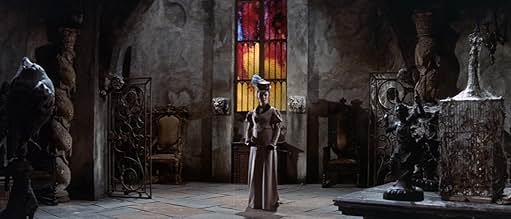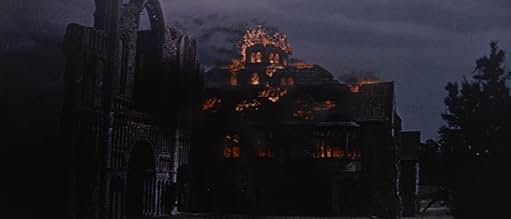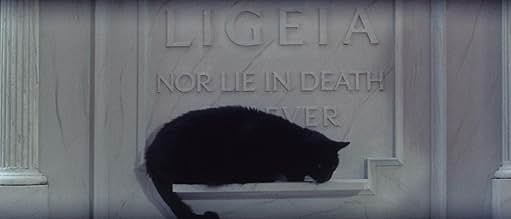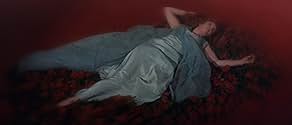ÉVALUATION IMDb
6,4/10
7,3 k
MA NOTE
L'obsession d'un homme pour sa femme décédée crée un fossé entre lui et sa nouvelle épouse.L'obsession d'un homme pour sa femme décédée crée un fossé entre lui et sa nouvelle épouse.L'obsession d'un homme pour sa femme décédée crée un fossé entre lui et sa nouvelle épouse.
- Director
- Writers
- Stars
Maxwell Craig
- Wedding Guest
- (uncredited)
Anthony Lang
- Wedding Guest
- (uncredited)
Del Watson
- Footman
- (uncredited)
Fred Wood
- Wedding Guest
- (uncredited)
Avis en vedette
I was asked recently if I could name any genuinely scary films made before The Exorcist in 1973. The only titles I could come up with were Rosemary's Baby and Night of the Living Dead from the late '60s. I could suggest many horror titles made before 1970, but none were genuinely flesh-crawling enough to make the list. At the time, I had not seen The Tomb of Ligeia. Now I have seen it and, wow! This is one seriously under-rated gem.
It is one of the many Roger Corman films from this era based on an Edgar Allan Poe story. Intelligently scripted by Robert Towne, and acted to perfection by Vincent Price and Elisabeth Shepherd, this film is a treat from start to finish. Shepherd plays a well-to-do lady in Victorian England who falls in love with a mysterious loner (Price) who resides in a crumbling abbey and seems haunted by memories of his previous (now-dead) wife Ligeia. She marries Price, but her chances of love are blighted by spooky happenings which may be the work of the ghost of his jealous ex-bride.
The dream sequence, featuring a dead fox hidden in a bouquet of flowers and a terrifying metamorphosis midway through a passionate kiss, is a marvellous and memorable scene. All scenes featuring the weird black cat are eerily effective. There's also a wonderfully creepy hypnotism episode. The photography is lovely, with colourful outdoor lensing of a real English abbey and superb blending of light and shadows during the ghostly indoor sequences.
So, if you're after a truly spine-tingling film from before 1970 - here you go!
It is one of the many Roger Corman films from this era based on an Edgar Allan Poe story. Intelligently scripted by Robert Towne, and acted to perfection by Vincent Price and Elisabeth Shepherd, this film is a treat from start to finish. Shepherd plays a well-to-do lady in Victorian England who falls in love with a mysterious loner (Price) who resides in a crumbling abbey and seems haunted by memories of his previous (now-dead) wife Ligeia. She marries Price, but her chances of love are blighted by spooky happenings which may be the work of the ghost of his jealous ex-bride.
The dream sequence, featuring a dead fox hidden in a bouquet of flowers and a terrifying metamorphosis midway through a passionate kiss, is a marvellous and memorable scene. All scenes featuring the weird black cat are eerily effective. There's also a wonderfully creepy hypnotism episode. The photography is lovely, with colourful outdoor lensing of a real English abbey and superb blending of light and shadows during the ghostly indoor sequences.
So, if you're after a truly spine-tingling film from before 1970 - here you go!
At one point in this film Vincent Price says 'Christopher, not ten minutes ago I tried to kill a stray cat with a cabbage'. Now, I think that is a pretty good reason alone to watch this movie but if that's not enough for you well, its another Roger Corman gothic horror starring Vincent the magnificent, based loosely on an Edgar Allen Poe story. There's nice sets and locations, lush cinematography, an above average script and Price doing what he does best, as well as vegetable-based violence directed at felines.
"Ligeia" is one of my very favorite E.A. Poe stories, a masterpiece of suspense that doesn't reveal its secret until the very last word. Like a lot of Poe's stories, however, the transformation to the screen isn't always an easy one. A great deal of the action in the short story takes place in the narrator's head, and to make a feature length movie out of it there must be some added action and characters.
The screenwriter here, Robert Towne, would go on to bigger and better things and garner fame and awards while doing it. But this early script of his is a rather modest one. The action drags more and more as the film goes on and the sense of horror and tension dissipates rather than builds as the film progresses. Plus there's that annoying black cat (left over from another Poe story, perhaps?)
What points this movie does get are for style. Roger Corman wasn't a schlock director by any means; he had a great eye and and gave his films a distinctive look and feel. The cast is a very good one as well. Vincent Price does the usual fine job we expect from him and I liked actress Elizabeth Shepard as the Lady Rowena, Price's wife who succeeds Ligeia. I wasn't familiar with her before seeing this movie and I found her very watchable. But 'The Tomb of Ligeia' is hardly classic Poe or a memorable horror film. But fans of Corman and the Hammer Films type of productions may want to see it.
The screenwriter here, Robert Towne, would go on to bigger and better things and garner fame and awards while doing it. But this early script of his is a rather modest one. The action drags more and more as the film goes on and the sense of horror and tension dissipates rather than builds as the film progresses. Plus there's that annoying black cat (left over from another Poe story, perhaps?)
What points this movie does get are for style. Roger Corman wasn't a schlock director by any means; he had a great eye and and gave his films a distinctive look and feel. The cast is a very good one as well. Vincent Price does the usual fine job we expect from him and I liked actress Elizabeth Shepard as the Lady Rowena, Price's wife who succeeds Ligeia. I wasn't familiar with her before seeing this movie and I found her very watchable. But 'The Tomb of Ligeia' is hardly classic Poe or a memorable horror film. But fans of Corman and the Hammer Films type of productions may want to see it.
There is an assumption among movie fans that the longer a movie series exists, the worse the later films will be. Although the films Roger Corman made of some of the stories of Edgar Allan Poe began well and continued with no obvious sense of decline, it is my opinion that the best was kept for last. The most overtly spectacular film in the series was 'The Masque of the Red Death' with its fine sense of colour and effective sense of homage to Ingmar Bergman's 'The Seventh Seal'. I have always enjoyed this film and in terms of a deliberate departure from the series norm, it is exceptional. However one enjoys any series for the familiar as well as the unusual, and in this respect 'The Tomb of Ligeia' is the most memorable for me in the way it builds upon and enhances what has gone on in previous films. The logical departure from the previous films which had been (very happily and effectively) studio-bound, was to move to location. Corman's choice of Castle Acre Priory in Norfolk, was an inspired one. An large amount of location filming was done there and this grounded the film in a realistic (yet unusual)setting. Gone were the fog machines and 'blasted heath' effects of 'House of Usher' and 'The Premature Burial'. Many critics have mentioned their disquiet at the absence of Barbara Steele, at that time undoubtedly the actress most associated with this type of picture. Wonderful though Miss Steele was in, say, the last thirty minutes of 'The Pit and the Pendulum', I feel that the presence of the English actress, Elizabeth Sheppard, adds to the sense of realisim, while taking little away from the shock effect of one actress playing both a good and an evil role. Roger Corman is on record as saying that he had to keep a written record as to when Rowena was herself and when she was Ligeia. All I can say that it is happily obvious on the screen when each side of the romantic coin is in evidence. I think that Elizabeth Sheppard's performance, grounded in reason, and when added to the inevitable polish that was being obtained by this stage in the series, showed a welcome extra sense of belief, to point out the advances and progression that had been made by this, the last film, in the series. Two scenes stand out : the entrapment of Rowena in the bell tower by the black cat (representing Ligeia.) I am also very impressed by Rowena's hynotism ; first to her own childhood and then to the persona of Ligeia. This film has not been available for viewing in the UK for many years. It is to be hoped that this situation will be reversed before long. I remember with affection the moment when great talents (from both sides of the 'pond') collaborated with great effcetiveness to come up with the ultimate 'Corman Classic'.
Amidst a crumbling castle in 19th century England, a widowed aristocrat (Vincent Price) mourns his wife, but quickly develops a new romantic relationship after meeting the forceful Rowena (Elizabeth Shepherd). Yet the soul of Ligeia seems to be haunting the estate and the apparently mesmerized Baron is hiding something.
Released in late 1964, "The Tomb of Ligeia" is Gothic horror based on the Edgar Allan Poe story from 1838 (which was revised in 1845 with the addition of his 1843 poem "The Conqueror Worm," written by the character Ligeia). This was the last of Roger Corman's eight Poe films from 1960-1964, which all made money but this one made the least, possibly because the quasi-series had run its course and the story was overly complicated. Nevertheless, Corman considered it one of the best of the lot.
Since the original tale was so short, scriptwriter Robert Towne incorporated elements from other Poe stories, such as the black cat, mesmerism and a hint of necrophilia. The talky story isn't as compelling as Corman's "The Terror" (1963) or even "The Masque of the Red Death" (1964). It's rather boring for the first hour, but there's an effectively creepy payoff in the last act, which ties everything together. Like those previous two films, the sumptuous Gothic ambiance is worth the price of admission and the inclusion of Stonehenge is a highlight. You just have to acclimate to the dated drama-focused goings-on.
The movie runs 1 hour, 22 minutes and was shot at Shepperton Studios, just west of London, and Castle Acre Priory north of Swaffham, as well as other spots in England, such as Stonehenge, Polesden Lacey and Polzeath, Cornwall, at the southwest tip of Britain (the beach scene).
GRADE: B-/C+
Released in late 1964, "The Tomb of Ligeia" is Gothic horror based on the Edgar Allan Poe story from 1838 (which was revised in 1845 with the addition of his 1843 poem "The Conqueror Worm," written by the character Ligeia). This was the last of Roger Corman's eight Poe films from 1960-1964, which all made money but this one made the least, possibly because the quasi-series had run its course and the story was overly complicated. Nevertheless, Corman considered it one of the best of the lot.
Since the original tale was so short, scriptwriter Robert Towne incorporated elements from other Poe stories, such as the black cat, mesmerism and a hint of necrophilia. The talky story isn't as compelling as Corman's "The Terror" (1963) or even "The Masque of the Red Death" (1964). It's rather boring for the first hour, but there's an effectively creepy payoff in the last act, which ties everything together. Like those previous two films, the sumptuous Gothic ambiance is worth the price of admission and the inclusion of Stonehenge is a highlight. You just have to acclimate to the dated drama-focused goings-on.
The movie runs 1 hour, 22 minutes and was shot at Shepperton Studios, just west of London, and Castle Acre Priory north of Swaffham, as well as other spots in England, such as Stonehenge, Polesden Lacey and Polzeath, Cornwall, at the southwest tip of Britain (the beach scene).
GRADE: B-/C+
Le saviez-vous
- AnecdotesShot on a 25 day schedule in the UK, a big difference to the 15 day schedule used in the US for the previous Roger Corman "Poe" movies. The director attributed the extra time to the British crew's obsession with taking "tea breaks."
- GaffesPosition of Ligeia's arms when lying in bed. When Rowena fall on her her arms are in a position like holding something. Few minutes later, when Verden take a look on the bed hidden by the black curtains, their arms are in other position.
- Citations
Verden Fell: Christopher, not ten minutes ago I... I tried to kill a stray cat with a cabbage, and all but made love to the Lady Rowena. I succeeded is squashing the cabbage and badly frightening the lady. If only I could lay open my own brain as easily as I did that vegetable, what rot would be freed from its grey leaves?
- ConnexionsFeatured in Nightwatch Presents Edgar Allan Poe: The Tomb of Ligeia (1973)
Meilleurs choix
Connectez-vous pour évaluer et surveiller les recommandations personnalisées
- How long is The Tomb of Ligeia?Propulsé par Alexa
- Is "The Tomb of Ligeia" based on a book?
- Where can I read Poe's "Ligeia" online?
- How is "Ligeia" pronounced?
Détails
- Date de sortie
- Pays d’origine
- Langue
- Aussi connu sous le nom de
- The Tomb of Ligeia
- Lieux de tournage
- société de production
- Consultez plus de crédits d'entreprise sur IMDbPro
- Durée1 heure 22 minutes
- Couleur
- Rapport de forme
- 2.35 : 1
Contribuer à cette page
Suggérer une modification ou ajouter du contenu manquant

Lacune principale
By what name was La tombe de Ligeia (1964) officially released in India in English?
Répondre



























